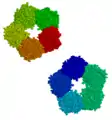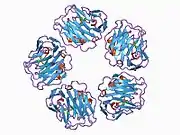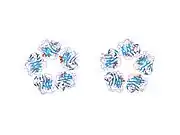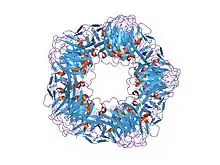C-reactive protein
| C-reactive protein | |
|---|---|
| Purpose | Detection of inflammation in body.[1] |
| Test of | The amount of CRP in the blood.[1] |
C-reactive protein (CRP) is an annular (ring-shaped) pentameric protein found in blood plasma, whose circulating concentrations rise in response to inflammation. It is an acute-phase protein of hepatic origin that increases following interleukin-6 secretion by macrophages and T cells. Its physiological role is to bind to lysophosphatidylcholine expressed on the surface of dead or dying cells (and some types of bacteria) in order to activate the complement system via C1q.[2]
CRP is made by the liver[3] in response to factors released by macrophages and fat cells (adipocytes).[4] It is a member of the pentraxin family of proteins.[3] It is not related to C-peptide (insulin) or protein C (blood coagulation). C-reactive protein was the first pattern recognition receptor (PRR) to be identified.[5]
Medical use
CRP is used mainly as an inflammation marker. Apart from liver failure, there are few known factors that interfere with CRP production.[3] Interferon alpha inhibits CRP production from liver cells which may explain the relatively low levels of CRP found during viral infections compared to bacterial infections [6][7]
Measuring and charting CRP values can prove useful in determining disease progress or the effectiveness of treatments. ELISA, immunoturbidimetry, nephelometry, radial immunodiffusion[8][9]
- low: hs-CRP level under 1.0 mg/L
- average: between 1.0 and 3.0 mg/L
- high: above 3.0 mg/L
Normal levels increase with aging.[10] Higher levels are found in late pregnant women, mild inflammation and viral infections (10–40 mg/L), active inflammation, bacterial infection (40–200 mg/L), severe bacterial infections and burns (>200 mg/L).[11]
CRP cut-off levels indicating bacterial from non-bacterial illness can vary due to co-morbidities such as malaria, HIV and malnutrition and the stage of disease presentation.[12]
CRP is a more sensitive and accurate reflection of the acute phase response than the ESR[13] (erythrocyte sedimentation rate). ESR may be normal while CRP is elevated. CRP returns to normal more quickly than ESR in response to therapy.
Cardiovascular disease
CRP is not useful for determining who is at risk of cardiovascular disease.[14]
Research suggests that people with elevated basal levels of CRP are at an increased risk of diabetes.[15][16]
In a meta-analysis of coronary artery disease, CRP levels were found to be reduced after exercise interventions. Among those studies, higher CRP concentrations or poorer lipid profiles before beginning exercise were associated with greater reductions in CRP.[17]
To clarify whether CRP is a bystander or active participant in atherogenesis, a 2008 study compared people with various genetic CRP variants. Those with a high CRP due to genetic variation had no increased risk of cardiovascular disease compared to those with a normal or low CRP.[18] A study published in 2011 shows that CRP is associated with lipid responses to low-fat and high-polyunsaturated fat diets.[19]
C-reactive protein is not recommended as a cardiovascular disease screening test for average-risk adults without symptoms.[20]
The American Heart Association and U.S. Centers for Disease Control and Prevention have defined risk groups as follows:[21][9]
- Low Risk: less than 1.0 mg/L
- Average risk: 1.0 to 3.0 mg/L
- High risk: above 3.0 mg/L
But hs-CRP is not to be used alone and should be combined with elevated levels of cholesterol, LDL-C, triglycerides, and glucose level. Smoking, hypertension and diabetes also increase the risk level of cardiovascular disease.
Fibrosis and inflammation
Scleroderma, polymyositis, and dermatomyositis elicit little or no CRP response. CRP levels also tend not to be elevated in SLE unless serositis or synovitis is present. Elevations of CRP in the absence of clinically significant inflammation can occur in kidney failure. CRP level is an independent risk factor for atherosclerotic disease. Patients with high CRP concentrations are more likely to develop stroke, myocardial infarction, and severe peripheral vascular disease.[22] Elevated level of CRP can also be observed in inflammatory bowel disease (IBD), including Crohn's disease and ulcerative colitis.[13]
High levels of CRP has been associated to point mutation Cys130Arg in the APOE gene, coding for apolipoprotein E, establishing a link between lipid values and inflammatory markers modulation.[23]
Cancer
The role of inflammation in cancer is not well understood. Some organs of the body show greater risk of cancer when they are chronically inflamed.[24] While there is an association between increased levels of C-reactive protein and risk of developing cancer, there is no association between genetic polymorphisms influencing circulating levels of CRP and cancer risk.[25]
In a 2004 prospective cohort study on colon cancer risk associated with CRP levels, people with colon cancer had higher average CRP concentrations than people without colon cancer.[26] It can be noted that the average CRP levels in both groups were well within the range of CRP levels usually found in healthy people. However, these findings may suggest that low inflammation level can be associated with a lower risk of colon cancer, concurring with previous studies that indicate anti-inflammatory drugs could lower colon cancer risk.[27]
Obstructive sleep apnea
C-reactive protein (CRP), a marker of systemic inflammation, is also increased in obstructive sleep apnea (OSA). CRP and interleukin-6 (IL-6) levels were significantly higher in patients with OSA compared to obese control subjects.[28] Patients with OSA have higher plasma CRP concentrations that increased corresponding to the severity of their apnea-hypopnea index score. Treatment of OSA with CPAP (continuous positive airway pressure) significantly alleviated the effect of OSA on CRP and IL-6 levels.[28]
Rheumatoid arthritis
In the context of RA, CRP is one of the acute phase reactants, whose assessment is defined as part of the joint 2010 ACR/EULAR classification criteria for RA with abnormal levels accounting for a single point within the criteria [29] Higher levels of CRP are associated with more severe disease and a higher likelihood of radiographic progression. Rheumatoid arthritis associated antibodies together with 14-3-3η YWHAH have been reported to complement CRP in predicting clinical and radiographic outcomes in patients with recent onset inflammatory polyarthritis.[30] Elevated levels of CRP appear to be associated with common comorbidities including cardiovascular disease, metabolic syndrome, diabetes and interstitial lung (pulmonary) disease. Mechanistically, CRP also appears to influence osteoclast activity leading to bone resorption and also stimulates RANKL expression in peripheral blood monocytes.[31]
It has previously been speculated that single-nucleotide polymorphisms in the CRP gene may affect clinical decision-making based on CRP in rheumatoid arthritis, e.g. DAS28 (Disease Activity Score 28 joints). A recent study showed that CRP genotype and haplotype were only marginally associated with serum CRP levels and without any association to the DAS28 score.[32] Thus, that DAS28, which is the core parameter for inflammatory activity in RA, can be used for clinical decision-making without adjustment for CRP gene variants.
Viral infections
Increased blood CRP levels were higher in people with avian flu H7N9 compared to those with H1N1 (more common) influenza,[33] with a review reporting that severe H1N1 influenza had elevated CRP.[34] In 2020, people infected with COVID-19 in Wuhan, China had elevated CRP.[35][36][37]
Serum levels
Measurement methods
Traditional CRP measurement only detected CRP in the range of 10 to 1,000 mg/L, whereas high sensitivity CRP (hs-CRP) detects CRP in the range of 0.5 to 10 mg/L.[38] hs-CRP can detect cardiovascular disease risk when in excess of 3 mg/L, whereas below 1 mg/L would be low risk.[9] Traditional CRP measurement is faster and less costly than hs-CRP, and can be adequate for some applications, such as monitoring hemodialysis patients.[39]
Normal
In healthy adults, the normal concentrations of CRP varies between 0.8 mg/L and 3.0 mg/L. However, some healthy adults show elevated CRP at 10 mg/L. CRP concentrations also increase with age, possibly due to subclinical conditions. There is also no seasonal variations of CRP concentrations. Gene polymorphism of interleukin-1 family, interleukin 6, and polymorphic GT repeat of the CRP gene do affect the usual CRP concentrations when a person does not have any medical illnesses.[3] The plasma half-life of CRP is 19 hours, and is constant in all medical conditions.[40]
Acute inflammation
When there is a stimulus, the CRP level can increase 10,000-fold from less than 50 μg/L to more than 500 mg/L. Its concentration can increase to 5 mg/L by 6 hours and peak at 48 hours. Therefore, the only factor that affects the blood CRP concentration is its production rate, which increases with inflammation, infection, trauma, necrosis, malignancy, and allergic reactions. Other inflammatory mediators that can increase CRP are TGF beta 1, and tumor necrosis factor alpha. In acute inflammation, CRP can increase as much as 50 to 100 mg/L within 4 to 6 hours in mild to moderate inflammation or an insult such as skin infection, cystitis, or bronchitis. It can double every 8 hours and reaches its peak at 36 to 50 hours following injury or inflammation. CRP between 100 and 500 mg/L is considered highly predictive of inflammation due to bacterial infection. Once inflammation subsides, CRP level falls quickly because of its relatively short half-life.[41]
Metabolic inflammation
CRP concentrations between 2 and 10 mg/L are considered as metabolic inflammation: metabolic pathways that cause arteriosclerosis[42] and type II diabetes mellitus[43]
History
Discovered by Tillett and Francis in 1930,[44] it was initially thought that CRP might be a pathogenic secretion since it was elevated in a variety of illnesses, including cancer.[3] The later discovery of hepatic synthesis (made in the liver) demonstrated that it is a native protein.[45][46][47] Initially, CRP was measured using the quellung reaction which gave a positive or a negative result. More precise methods nowadays use dynamic light scattering after reaction with CRP-specific antibodies.[41]
Name
CRP was so named because it was first identified as a substance in the serum of patients with acute inflammation that reacted with the cell wall polysaccharide (C-polysaccharide) of pneumococcus.[48]
Genetics and structure
The CRP gene is located on chromosome 1 (1q23.2[49]). It is a member of the small pentraxins family. The monomer has 224 amino acids[50] and molecular mass of 25,106 Da. The complete protein, composed of five monomers, has a total mass of approximately 120,000 Da. In serum, it assembles into stable pentameric structure with a discoid shape.[51]
Function
CRP binds to the phosphocholine expressed on the surface of bacterial cells such as pneumococcus bacteria. This activates the complement system, promoting phagocytosis by macrophages, which clears necrotic and apoptotic cells and bacteria.[52]>[41]
This so-called acute phase response occurs as a result of increasing concentrations of IL-6, which is produced by macrophages[3] as well as adipocytes[4] in response to a wide range of acute and chronic inflammatory conditions such as bacterial, viral, or fungal infections; rheumatic and other inflammatory diseases; malignancy; and tissue injury and necrosis. These conditions cause release of interleukin-6 and other cytokines that trigger the synthesis of CRP and fibrinogen by the liver.
CRP binds to phosphocholine on micro-organisms. It is thought to assist in complement binding to foreign and damaged cells and enhances phagocytosis by macrophages (opsonin-mediated phagocytosis), which express a receptor for CRP. It plays a role in innate immunity as an early defense system against infections.[41]
 C-reactive protein
C-reactive protein C-reactive protein
C-reactive protein
References
- 1 2 "C-Reactive Protein (CRP)". Lab Tests Online. Archived from the original on 2019-11-05. Retrieved 2019-12-23.
- ↑ Thompson D, Pepys MB, Wood SP (February 1999). "The physiological structure of human C-reactive protein and its complex with phosphocholine". Structure. 7 (2): 169–177. doi:10.1016/S0969-2126(99)80023-9. PMID 10368284.
- 1 2 3 4 5 6 Pepys MB, Hirschfield GM (June 2003). "C-reactive protein: a critical update". The Journal of Clinical Investigation. 111 (12): 1805–1812. doi:10.1172/JCI18921. PMC 161431. PMID 12813013.
- 1 2 Lau DC, Dhillon B, Yan H, Szmitko PE, Verma S (May 2005). "Adipokines: molecular links between obesity and atheroslcerosis". American Journal of Physiology. Heart and Circulatory Physiology. 288 (5): H2031–H2041. doi:10.1152/ajpheart.01058.2004. PMID 15653761.
- ↑ Mantovani A, Garlanda C, Doni A, Bottazzi B (January 2008). "Pentraxins in innate immunity: from C-reactive protein to the long pentraxin PTX3". Journal of Clinical Immunology. 28 (1): 1–13. doi:10.1007/s10875-007-9126-7. PMID 17828584. S2CID 20300531.
- ↑ Enocsson H, Sjöwall C, Skogh T, Eloranta ML, Rönnblom L, Wetterö J (December 2009). "Interferon-alpha mediates suppression of C-reactive protein: explanation for muted C-reactive protein response in lupus flares?". Arthritis and Rheumatism. 60 (12): 3755–3760. doi:10.1002/art.25042. PMID 19950271.
- ↑ Enocsson H, Gullstrand B, Eloranta ML, Wetterö J, Leonard D, Rönnblom L, et al. (2020). "C-Reactive Protein Levels in Systemic Lupus Erythematosus Are Modulated by the Interferon Gene Signature and CRP Gene Polymorphism rs1205". Frontiers in Immunology. 11: 622326. doi:10.3389/fimmu.2020.622326. PMC 7876312. PMID 33584722.
- ↑ Grützmeier S, von Schenck H (March 1989). "Four immunochemical methods for measuring C-reactive protein in plasma compared". Clinical Chemistry. 35 (3): 461–463. doi:10.1093/clinchem/35.3.461. PMID 2493344.
- 1 2 3 Pearson TA, Mensah GA, Alexander RW, Anderson JL, Cannon RO, Criqui M, et al. (January 2003). "Markers of inflammation and cardiovascular disease: application to clinical and public health practice: A statement for healthcare professionals from the Centers for Disease Control and Prevention and the American Heart Association". Circulation. 107 (3): 499–511. doi:10.1161/01.cir.0000052939.59093.45. PMID 12551878.
- ↑ Thomas, Lothar, Labor und Diagnose. TH-Books, Frankfurt, 2008, p. 1010
- ↑ Chew KS (April 2012). "What's new in Emergencies Trauma and Shock? C-reactive protein as a potential clinical biomarker for influenza infection: More questions than answers". Journal of Emergencies, Trauma, and Shock. 5 (2): 115–117. doi:10.4103/0974-2700.96477. PMC 3391832. PMID 22787338.
- ↑ Dittrich S, Tadesse BT, Moussy F, Chua A, Zorzet A, Tängdén T, et al. (2016-08-25). Yansouni C (ed.). "Target Product Profile for a Diagnostic Assay to Differentiate between Bacterial and Non-Bacterial Infections and Reduce Antimicrobial Overuse in Resource-Limited Settings: An Expert Consensus". PLOS ONE. 11 (8): e0161721. Bibcode:2016PLoSO..1161721D. doi:10.1371/journal.pone.0161721. PMC 4999186. PMID 27559728.
- 1 2 Liu S, Ren J, Xia Q, Wu X, Han G, Ren H, et al. (December 2013). "Preliminary case-control study to evaluate diagnostic values of C-reactive protein and erythrocyte sedimentation rate in differentiating active Crohn's disease from intestinal lymphoma, intestinal tuberculosis and Behcet's syndrome". The American Journal of the Medical Sciences. 346 (6): 467–472. doi:10.1097/MAJ.0b013e3182959a18. PMID 23689052. S2CID 5173681.
- ↑ Ton, Joey (15 May 2009). "#1 CRP = CV?: Should We React to C-Reactive Protein?". CFPCLearn. Archived from the original on 30 June 2023. Retrieved 14 June 2023.
- ↑ Pradhan AD, Manson JE, Rifai N, Buring JE, Ridker PM (July 2001). "C-reactive protein, interleukin 6, and risk of developing type 2 diabetes mellitus". JAMA. 286 (3): 327–334. doi:10.1001/jama.286.3.327. PMID 11466099.
- ↑ Dehghan A, Kardys I, de Maat MP, Uitterlinden AG, Sijbrands EJ, Bootsma AH, et al. (March 2007). "Genetic variation, C-reactive protein levels, and incidence of diabetes". Diabetes. 56 (3): 872–878. doi:10.2337/db06-0922. PMID 17327459.
- ↑ Swardfager W, Herrmann N, Cornish S, Mazereeuw G, Marzolini S, Sham L, Lanctôt KL (April 2012). "Exercise intervention and inflammatory markers in coronary artery disease: a meta-analysis". American Heart Journal. 163 (4): 666–76.e1–3. doi:10.1016/j.ahj.2011.12.017. PMID 22520533.
- ↑ Zacho J, Tybjaerg-Hansen A, Jensen JS, Grande P, Sillesen H, Nordestgaard BG (October 2008). "Genetically elevated C-reactive protein and ischemic vascular disease". The New England Journal of Medicine. 359 (18): 1897–1908. doi:10.1056/NEJMoa0707402. PMID 18971492.
- ↑ St-Onge MP, Zhang S, Darnell B, Allison DB (April 2009). "Baseline serum C-reactive protein is associated with lipid responses to low-fat and high-polyunsaturated fat diets". The Journal of Nutrition. 139 (4): 680–683. doi:10.3945/jn.108.098251. PMC 2666362. PMID 19297430.
- ↑ Goldman L (2011). Goldman's Cecil Medicine (24th ed.). Philadelphia: Elsevier Saunders. pp. 54. ISBN 978-1437727883.
- ↑ "hs-CRP". Archived from the original on August 20, 2013. Retrieved June 3, 2013.
- ↑ Clearfield MB (September 2005). "C-reactive protein: a new risk assessment tool for cardiovascular disease". The Journal of the American Osteopathic Association. 105 (9): 409–416. PMID 16239491. Archived from the original on 2012-01-10. Retrieved 2013-02-10.
- ↑ Sidore C, Busonero F, Maschio A, Porcu E, Naitza S, Zoledziewska M, et al. (November 2015). "Genome sequencing elucidates Sardinian genetic architecture and augments association analyses for lipid and blood inflammatory markers". Nature Genetics. 47 (11): 1272–1281. doi:10.1038/ng.3368. PMC 4627508. PMID 26366554.
- ↑ Lu H, Ouyang W, Huang C (April 2006). "Inflammation, a key event in cancer development". Molecular Cancer Research. 4 (4): 221–233. doi:10.1158/1541-7786.MCR-05-0261. PMID 16603636.
- ↑ Allin KH, Nordestgaard BG (2011). "Elevated C-reactive protein in the diagnosis, prognosis, and cause of cancer". Critical Reviews in Clinical Laboratory Sciences. 48 (4): 155–170. doi:10.3109/10408363.2011.599831. PMID 22035340. S2CID 40322991.
- ↑ Erlinger TP, Platz EA, Rifai N, Helzlsouer KJ (February 2004). "C-reactive protein and the risk of incident colorectal cancer". JAMA. 291 (5): 585–590. doi:10.1001/jama.291.5.585. PMID 14762037.
- ↑ Baron JA, Cole BF, Sandler RS, Haile RW, Ahnen D, Bresalier R, et al. (March 2003). "A randomized trial of aspirin to prevent colorectal adenomas". The New England Journal of Medicine. 348 (10): 891–899. doi:10.1056/NEJMoa021735. PMID 12621133.
- 1 2 Latina JM, Estes NA, Garlitski AC (2013). "The Relationship between Obstructive Sleep Apnea and Atrial Fibrillation: A Complex Interplay". Pulmonary Medicine. 2013: 621736. doi:10.1155/2013/621736. PMC 3600315. PMID 23533751.
- ↑ Kay J, Upchurch KS. ACR/EULAR 2010 rheumatoid arthritis classification criteria. Rheumatology (Oxford). 2012 Dec;51 Suppl 6:vi5-9. doi: 10.1093/rheumatology/kes279. PMID 23221588.
- ↑ Carrier N, Marotta A, de Brum-Fernandes AJ, Liang P, Masetto A, Ménard HA, et al. (February 2016). "Serum levels of 14-3-3η protein supplement C-reactive protein and rheumatoid arthritis-associated antibodies to predict clinical and radiographic outcomes in a prospective cohort of patients with recent-onset inflammatory polyarthritis". Arthritis Research & Therapy. 18 (37): 37. doi:10.1186/s13075-016-0935-z. PMC 4736641. PMID 26832367. S2CID 1926353.
- ↑ Pope JE, Choy EH (February 2021). "C-reactive protein and implications in rheumatoid arthritis and associated comorbidities". Seminars in Arthritis and Rheumatism. 51 (1): 219–229. doi:10.1016/j.semarthrit.2020.11.005. PMID 33385862. S2CID 230108148.
- ↑ Ammitzbøll CG, Steffensen R, Bøgsted M, Hørslev-Petersen K, Hetland ML, Junker P, et al. (October 2014). "CRP genotype and haplotype associations with serum C-reactive protein level and DAS28 in untreated early rheumatoid arthritis patients". Arthritis Research & Therapy. 16 (5): 475. doi:10.1186/s13075-014-0475-3. PMC 4247621. PMID 25359432.
- ↑ Wu W, Shi D, Fang D, Guo F, Guo J, Huang F, et al. (March 2016). "A new perspective on C-reactive protein in H7N9 infections". International Journal of Infectious Diseases. 44: 31–36. doi:10.1016/j.ijid.2016.01.009. PMID 26809124.
- ↑ Vasileva D, Badawi A (January 2019). "C-reactive protein as a biomarker of severe H1N1 influenza". Inflammation Research. 68 (1): 39–46. doi:10.1007/s00011-018-1188-x. PMC 6314979. PMID 30288556.
- ↑ Wang D, Hu B, Hu C, Zhu F, Liu X, Zhang J, et al. (March 2020). "Clinical Characteristics of 138 Hospitalized Patients With 2019 Novel Coronavirus-Infected Pneumonia in Wuhan, China". JAMA. 323 (11): 1061–1069. doi:10.1001/jama.2020.1585. PMC 7042881. PMID 32031570.
- ↑ Chen N, Zhou M, Dong X, Qu J, Gong F, Han Y, et al. (February 2020). "Epidemiological and clinical characteristics of 99 cases of 2019 novel coronavirus pneumonia in Wuhan, China: a descriptive study". Lancet. 395 (10223): 507–513. doi:10.1016/S0140-6736(20)30211-7. PMC 7135076. PMID 32007143.
- ↑ Zhang J, Zhou L, Yang Y, Peng W, Wang W, Chen X (March 2020). "Therapeutic and triage strategies for 2019 novel coronavirus disease in fever clinics". The Lancet. Respiratory Medicine. 8 (3): e11–e12. doi:10.1016/S2213-2600(20)30071-0. PMC 7159020. PMID 32061335.
- ↑ Knight ML (February 18, 2015). "The Application of High-Sensitivity C-Reactive Protein in Clinical Practice: A 2015 Update". Cardiovascular. U.S. Pharmacist. Archived from the original on 2021-01-06. Retrieved 2020-12-28.
- ↑ Helal I, Zerelli L, Krid M, ElYounsi F, Ben Maiz H, Zouari B, et al. (May 2012). "Comparison of C-reactive protein and high-sensitivity C-reactive protein levels in patients on hemodialysis" (PDF). Saudi Journal of Kidney Diseases and Transplantation. 23 (3): 477–483. PMID 22569431. Archived from the original (PDF) on 2021-12-09. Retrieved 2020-12-28.
- ↑ Vigushin DM, Pepys MB, Hawkins PN (April 1993). "Metabolic and scintigraphic studies of radioiodinated human C-reactive protein in health and disease". The Journal of Clinical Investigation. 91 (4): 1351–1357. doi:10.1172/JCI116336. PMC 288106. PMID 8473487.
- 1 2 3 4 Bray C, Bell LN, Liang H, Haykal R, Kaiksow F, Mazza JJ, Yale SH (December 2016). "Erythrocyte Sedimentation Rate and C-reactive Protein Measurements and Their Relevance in Clinical Medicine" (PDF). WMJ. 115 (6): 317–321. PMID 29094869. Archived (PDF) from the original on 2018-02-18. Retrieved 2023-06-05.
- ↑ Nilsson J (August 2005). "CRP--marker or maker of cardiovascular disease?". Arteriosclerosis, Thrombosis, and Vascular Biology. 25 (8): 1527–1528. doi:10.1161/01.ATV.0000174796.81443.3f. PMID 16055753.
- ↑ Wang X, Bao W, Liu J, Ouyang YY, Wang D, Rong S, et al. (January 2013). "Inflammatory markers and risk of type 2 diabetes: a systematic review and meta-analysis". Diabetes Care. 36 (1): 166–175. doi:10.2337/dc12-0702. PMC 3526249. PMID 23264288.
- ↑ Tillett WS, Francis T (September 1930). "Serological Reactions in Pneumonia with a Non-Protein Somatic Fraction of Pneumococcus". The Journal of Experimental Medicine. 52 (4): 561–571. doi:10.1084/jem.52.4.561. PMC 2131884. PMID 19869788.
- ↑ Kennelly PJ, Murray RF, Rodwell VW, Botham KM (2009). Harper's illustrated biochemistry. McGraw-Hill Medical. ISBN 978-0-07-162591-3.
- ↑ Pincus MR, McPherson RA, Henry JB (2007). Henry's clinical diagnosis and management by laboratory methods. Saunders Elsevier. ISBN 978-1-4160-0287-1.
- ↑ Ratey JJ, Noskin GA, Braun R, Hanley EN Jr, McInnes IB, Ruddy S (2008). Kelley's Textbook of Rheumatology: 2-Volume Set, Expert Consult: Online and Print (Textbook of Rheumatology (Kelley's)(2 Vol)). Philadelphia: Saunders. ISBN 978-1-4160-3285-4.
- ↑ Mold C, Nakayama S, Holzer TJ, Gewurz H, Du Clos TW (November 1981). "C-reactive protein is protective against Streptococcus pneumoniae infection in mice". The Journal of Experimental Medicine. 154 (5): 1703–1708. doi:10.1084/jem.154.5.1703. PMC 2186532. PMID 7299351.
- ↑ "CRP C-reactive protein [Homo sapiens]". Entrez Gene. National Center for Biotechnology Information (NCBI), U.S. National Library of Medicine. Archived from the original on 2023-03-15. Retrieved 2023-06-05.
- ↑ "#CAA39671". NCBI Entrez Protein. Archived from the original on 2023-06-30. Retrieved 2023-06-05.
- ↑ "Human C-reactive protein complexed with phosphocholine". Protein Data Bank in Europe. Archived from the original on 2022-07-06. Retrieved 2023-06-05.
- ↑ Enocsson H, Karlsson J, Li HY, Wu Y, Kushner I, Wetterö J, Sjöwall C (December 2021). "The Complex Role of C-Reactive Protein in Systemic Lupus Erythematosus". Journal of Clinical Medicine. 10 (24): 5837. doi:10.3390/jcm10245837. PMC 8708507. PMID 34945133.
External links
- MedlinePlus Encyclopedia: C-reactive protein
- Inflammation, Heart Disease and Stroke: The Role of C-Reactive Protein Archived 2010-02-08 at the Wayback Machine (American Heart Association)
- C-Reactive+Protein at the US National Library of Medicine Medical Subject Headings (MeSH)
- CRP: analyte monograph Archived 2020-04-05 at the Wayback Machine - The Association for Clinical Biochemistry and Laboratory Medicine
- George Vrousgos, N.D. - Southern Cross University Archived 2020-02-18 at the Wayback Machine
- Human CRP genome location and CRP gene details page in the UCSC Genome Browser.
- Overview of all the structural information available in the PDB for UniProt: P02741 (C-reactive protein) at the PDBe-KB.


